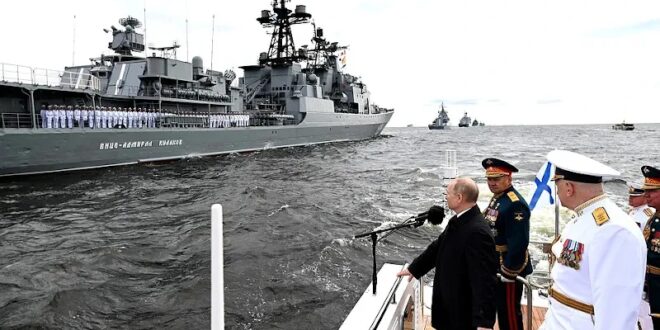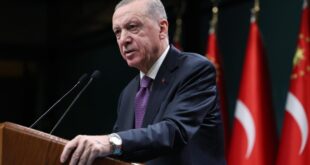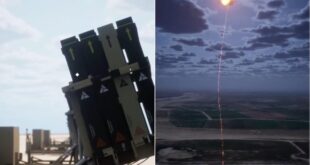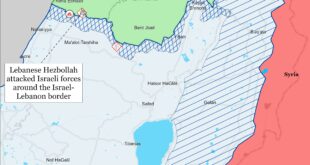Shortly after the conclusion of the Russian-Belarusian strategic Zapad-2021 exercise, open-source analysts, corroborated by U.S. intelligence findings, began reporting a new build-up of Russian forces on the Ukrainian border. Though most tracking concentrates on the movement of Russian Ground Forces equipment, the Russian Navy has also been moving, albeit at a smaller scale.
Since the outbreak of Russia-Ukraine violence in 2014, the flashpoint has been the south and east of Ukraine. The annexation of Crimea and years-long war in the Donbas have consumed most public attention, but the Russian government consistently maintains that localopposition to Kyiv is rooted not in the “Donbas” but in “southern and eastern Ukraine.” Moscow’s priority reflects the greater prominence of the Russian language in the south and east relative to the rest of the country as well as the concentration of strategic industries from the Soviet era, particularly the Yuzhmash rocket manufacturer in Dnipro and the large shipyards in Mykolaiv.
Thus, the Ground Forces buildup on Ukraine’s northern border and the long-distance movement of forces as far as 7,000 km from Russia’s Far East to Belarus distract from the political priority of Ukraine’s south and east in hypothetical Russian attack. Although there are some Russian force concentrations on Crimea, the peninsula is only attached to the mainland at three narrow points, suggesting the Russian Navy (Russian acronym VMF) may play a critical role in a possible conventional escalation between the two countries.
Plagued for centuries by limited access to the sea, the VMF has four fleets and one flotilla separated from one another by hundreds or thousands of kilometers: the Baltic Fleet, Black Sea Fleet, Pacific Fleet, Northern (Arctic) Fleet, and Caspian Flotilla. In recent weeks, the Northern Fleet and Baltic Fleets moved six large landing ships into the Mediterranean Sea, transiting the Strait of Gibraltar on 27 January and stopping at the Russian naval facility in Tartus, Syria, by 4 February. In addition, the Pacific Fleet’s Varyag cruiser and Admiral Tributs destroyer supported by the Boris Botuma supply ship transited the Suez Canal into the Mediterranean Sea on 2 February. These ships had been conducting exercises and goodwill stops in the Indian Ocean—including a trilateral anti-piracy exercise with Iran and China on 21 January. Pacific Fleet movement into the Mediterranean is not unprecedented but is infrequent. The Varyag last deployed to the Mediterranean Sea in 2016 during the high-intensity phase of the Russian intervention in Syria. Furthermore, the Varyag and Admiral Tributs comprise two of the only five Pacific Fleet warships based near Vladivostok that have ventured south of the Tsushima Strait in recent years.
The movement of these nine ships into the Mediterranean Sea raises concerns and questions. As with much else of the Russian large surface combatant fleet, nearly all these ships date back to the 1980s, two are from the 1970s, and only one—the Pyotr Morgunov landing ship from the Northern Fleet—is post-Soviet, commissioned in 2020. The Black Sea Fleet, long held back from modernization by Ukrainian legal restrictions when Kyiv controlled Crimea, boasts landing ships and surface combatants even older than these aging transplants. so As such, this assistance actually reduces the average age of the assets most likely to take part in a possible operation.
The Black Sea Fleet itself exercises primarily amphibious and coastal defense capabilities. Amphibious exercises may represent a growing Russian interest in expeditionary capabilities—Black Sea Fleet landing ships spend most of their time ferrying supplies to Tartus to maintain the Russian presence in Syria. However, these two capabilities are more likely geared toward defending and reinforcing Crimea from a hypothetical Ukrainian or NATO attack. Indeed, Crimea seemed to be the primary focus of the Kavkaz-2016 strategic exercise. Nevertheless, the movement of six large landing ships to complement the seven vintage yet functional landing ships based in Sevastopol suggests a strong VMF focus on amphibious extension of the Ukrainian frontline if the current war scare turns into a conventional war. As each of these ships can only carry roughly a heavy company, these thirteen ships could at most move three full-strength battalion tactical groups (BTGs) at any given time.
Three major approaches could forge the path to escalation. The first and least ambitious is to deploy in the Sea of Azov behind the current Ukrainian frontline in the Donbas west of Mariupol. The coast here is relatively open and the terrain of southeast Ukraine is among the flattest and most open in the world. Such a landing could theoretically be tried in conjunction with a larger Ground Forces breakout near Kharkiv to attempt to surround the Ukrainian defenders forward-deployed against the Donetsk and Luhansk separatist forces. Though simple at first glance of the map, such an operation would cover enormous distance and carry immense risks if the Russians could not maintain flow of supplies across the Sea of Azov long enough to meet with other Russian forces either at the Donbas frontline or one of the Crimean isthmuses, or cutting more than 400 km across hostile territory from Ukraine’s northeast border.
The second option features an amphibious landing west of Crimea, south of Kherson, and east of the Dnepr River liman entering the Black Sea. Though the usable coastline here is shorter, it is also relatively open and can be used to divide Ukrainian forces screening the Crimean border. This would offer a rapid approach to the water pipelines irrigating the arid California-like Crimean peninsula, which have been closed since 2014. Though water shortages have been reduced in severity by the opening of the Kerch Bridge in 2018, regaining access to the bountiful water resources of the Dnepr River would solve end Crimean water scarcity. The key drawback here is that defending southern Kherson Oblast is substantially more difficult than holding the small Crimean isthmuses to the mainland, and the Crimean water pipelines are a ripe target for sabotage. Such an escalation would almost certainly provoke at least a conventional Ukrainian counterattack. Though the Russian Armed Forces would be favored to defeat such an attack, it would demand more Russian forces hold territory in Ukraine than post in or near the Donbas and in Crimea itself.
The third and perhaps most ambitious option would involve landing further west as part of an effort to capture Odessa or even Mykolaiv. West of the Dnepr River, the Ukrainian Black Sea coast is characterized by escarpments, so potential landing sites are slim, and are generally beachfront communities, such as around the silt buildups of the western limans. Though Odessa is a Russophone city, with perhaps the most Russophilic population left in Ukraine, it is defended by the Ukrainian Marines—many of whom vividly remember their eviction from Crimea firsthand. Mykolaiv also proved far less receptive to the initially peaceful Antimaidan protests in March 2014 that prompted Russian intervention in the east. Gaining these cities would reclaim critical industrial capacity, but seizure would surely cripple any hope of maintaining a pro-Russian fraction of the Ukrainian electorate that could feasibly halt Kyiv’s move towards westward integration.
Each of these options is classified as high-risk, moderately high-reward. The viability of an amphibious escalation against Ukraine and of the VMF’s buildup at large is uncertain. The ships the VMF has imported to the Mediterranean Sea do not yet feature the new sea-launched cruise missiles (SLCMs) on which the Russian surface fleet prides itself—the Varyag has only launched a 1980s vintage Vulkan SLCM (SS-N-12) in recent exercises. Russian large surface combatants are aging because the VMF has prioritized procurement of smaller corvettes and frigates with longer-range SLCMs such as the Kalibr, and soon the Tsirkon, in the 21st century. Notably, these assets have not yet moved closer to Ukraine despite the VMF’s history of deploying the Baltic Fleet’s missile corvettes into the North Sea and North Atlantic Ocean and moving the Northern Fleet’s large surface combatants and small missile craft into the Black Sea itself.
At least as interesting is the question of Russian submarines in this buildup. VMF submarines are far more potent than its surface fleet but open-source reporting indicates no unusual submarine movement, save the return of the Black Sea Fleet’s Novorossiysk diesel-electric submarine to the Mediterranean from repairs on 27 December 2021.
The obvious problem potentially restricting Russian submarine movement is the Montreux Convention, which regulates maritime deployments in the Black Sea. Among other restrictions, the Convention limits submarine transits to repair trips, a regulation stretched by Black Sea Fleet submarines operating in the Mediterranean Sea for months on either end of a tune-up at a shipyard elsewhere in Russia. For example, the Novorossiysk submarine mentioned above has been operating over a month in the Mediterranean Sea since transiting the Strait of Gibraltar from a repair stop, despite its escort returning to the Black Sea via the Bosporus only 10 days later.
Notably, VMF ships relocated from other fleets to the Mediterranean Sea as opposed to the Black Sea. Article 21 of the Montreux Convention empowers Turkey to turn away warships from countries with which it is at war or feels threatened. Turkey, a NATO member, therefore, could block these ships’ movement into the Black Sea. Visiting warships can spend no more than 21 days in the Black Sea under the Convention, so Russia may simply be camping naval reinforcements in the Mediterranean until closer to the intended date of aggression.
When the VMF fired a Kalibr SLCM from the Caspian Sea to targets in Syria in the early phases of the Russian intervention in Syria in 2015, it became clear Russian ships can have a tactical effect from a great range. However, the Vulkan SLCM aboard the Varyag does not have the range to hit even Odessa from the Mediterranean Sea. Furthermore, amphibious ships are of little use attacking Ukraine in the Mediterranean. One possibility to consider is that the longest-range currently-deployed variant of the Kalibr SLCM could be fired from the Baltic Sea to as far as the Caucasus. In other words, the absence of missile craft redeployments is because they are not necessary.
The shock value of Russian SLCMs flying over Europe would certainly be profound, though this long-range variant is probably not available in sufficient quantities to achieve anything approaching indirect fire saturation. However, Ukraine’s proximity to Russia means that ground- and air-based fires can more than offset whatever capability might be needed from the sea, a boon absent in Syria. In addition, the Black Sea Fleet has been replenished since 2014 with six Varshavyanka-class submarines armed with Kalibr-PL SLCMs that may render interfleet transfer of such capabilities redundant, though these are generally exercised in an anti-ship capacity. In addition, three of those six submarines are currently deployed in the Mediterranean.
On the opposing side, Ukraine does possess a handful of Neptune coastal anti-ship missiles as of 2021. Though these systems would likely be able to cripple a Russian amphibious landing or other major surface assets in the Black Sea, the VMF or Russian Aerospace Force would likely target these systems in the opening minutes or hours of any conventional escalation with Ukraine.
All told, the VMF may provide an important mechanism for Russian extension of the Ukrainian defensive front if the current war scare erupts into open conflict. It may even prove vital in achieving some of the most politically important objectives of the military operation. To date, VMF movements suggest only a modest interest in augmenting amphibious capabilities in the Black Sea, but the force is poised to support fires from the Baltic and Caspian Seas alongside the increasing number of Russian noncontact options for warfare.
 Eurasia Press & News
Eurasia Press & News




